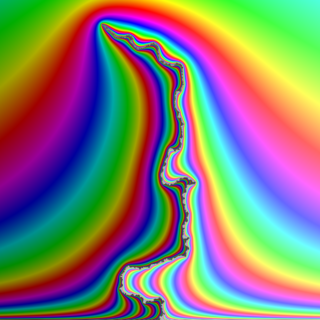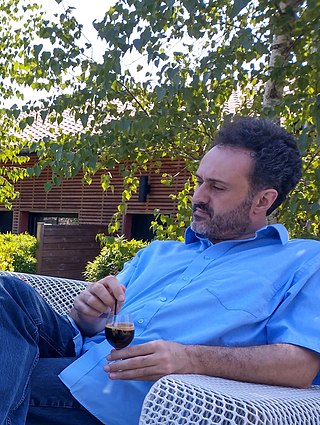
Jean Louis, baron Bourgain was a Belgian mathematician. He was awarded the Fields Medal in 1994 in recognition of his work on several core topics of mathematical analysis such as the geometry of Banach spaces, harmonic analysis, ergodic theory and nonlinear partial differential equations from mathematical physics.
In mathematics, the Milnor conjecture was a proposal by John Milnor of a description of the Milnor K-theory (mod 2) of a general field F with characteristic different from 2, by means of the Galois cohomology of F with coefficients in Z/2Z. It was proved by Vladimir Voevodsky.

In probability theory, the Schramm–Loewner evolution with parameter κ, also known as stochastic Loewner evolution (SLEκ), is a family of random planar curves that have been proven to be the scaling limit of a variety of two-dimensional lattice models in statistical mechanics. Given a parameter κ and a domain U in the complex plane, it gives a family of random curves in U, with κ controlling how much the curve turns. There are two main variants of SLE, chordal SLE which gives a family of random curves from two fixed boundary points, and radial SLE, which gives a family of random curves from a fixed boundary point to a fixed interior point. These curves are defined to satisfy conformal invariance and a domain Markov property.

In mathematics, specifically algebraic geometry, a period or algebraic period is a complex number that can be expressed as an integral of an algebraic function over an algebraic domain. The periods are a class of numbers which includes, alongside the algebraic numbers, many well known mathematical constants such as the number π. Sums and products of periods remain periods, such that the periods form a ring.
In mathematics, the field with one element is a suggestive name for an object that should behave similarly to a finite field with a single element, if such a field could exist. This object is denoted F1, or, in a French–English pun, Fun. The name "field with one element" and the notation F1 are only suggestive, as there is no field with one element in classical abstract algebra. Instead, F1 refers to the idea that there should be a way to replace sets and operations, the traditional building blocks for abstract algebra, with other, more flexible objects. Many theories of F1 have been proposed, but it is not clear which, if any, of them give F1 all the desired properties. While there is still no field with a single element in these theories, there is a field-like object whose characteristic is one.
In mathematics, Arakelov theory is an approach to Diophantine geometry, named for Suren Arakelov. It is used to study Diophantine equations in higher dimensions.
Lothar Göttsche is a German mathematician, known for his work in algebraic geometry.

Alexander B. Goncharov is a Soviet American mathematician and the Philip Schuyler Beebe Professor of Mathematics at Yale University. He won the EMS Prize in 1992.

Christopher Deninger is a German mathematician at the University of Münster. Deninger's research focuses on arithmetic geometry, including applications to L-functions.
Nets Hawk Katz is the W.L. Moody Professor of Mathematics at Rice University. He was a professor of mathematics at Indiana University Bloomington until March 2013 and the IBM Professor of Mathematics at the California Institute of Technology until 2023. He is currently the W. L. Moody Professor of Mathematics at Rice University.
Anna Gennadievna Erschler, née Dyubina,, is a Russian mathematician working in France. She specializes in geometric group theory and probability theory, in particular, random walks on groups.
Prakash Belkale is an Indian-American mathematician, specializing in algebraic geometry and representation theory.

Jean-Pierre Demailly was a French mathematician who worked in complex geometry. He was a professor at Université Grenoble Alpes and a permanent member of the French Academy of Sciences.

Viktor L. Ginzburg is a Russian-American mathematician who has worked on Hamiltonian dynamics and symplectic and Poisson geometry. As of 2017, Ginzburg is Professor of Mathematics at the University of California, Santa Cruz.

Bertrand Toën is a mathematician who works as a director of research at the Centre national de la recherche scientifique (CNRS) at the Paul Sabatier University, Toulouse, France. He received his PhD in 1999 from the Paul Sabatier University, where he was supervised by Carlos Simpson and Joseph Tapia.

Yves André is a French mathematician, specializing in arithmetic geometry.
Vincent Pilloni is a French mathematician, specializing in arithmetic geometry and the Langlands program.
Shai Haran is an Israeli mathematician and professor at the Technion – Israel Institute of Technology. He is known for his work in p-adic analysis, p-adic quantum mechanics, and non-additive geometry, including the field with one element, in relation to strategies for proving the Riemann Hypothesis.
Tanguy Rivoal is a French mathematician specializing in number theory and related fields. He is known for his work on transcendental numbers, special functions, and Diophantine approximation. He currently holds the position of Directeur de recherche at the Centre National de la Recherche Scientifique (CNRS) and is affiliated with the Université Grenoble Alpes.











